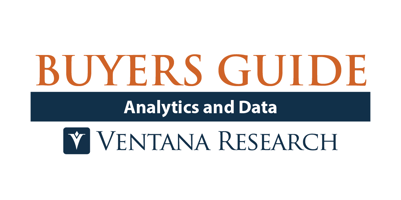Analytics and Data Buyers Guide 2023: Market Observations
The 2023 Ventana Research Buyers Guide for Analytics and Data research enables me to provide observations about how the market has advanced.
The processes and technology of the analytics and data software industry continue to play an instrumental role in enabling an organization’s business units and IT to optimally utilize data  in both tactical and strategic ways. To accomplish this, organizations must provide technology that can access the data, generate and apply insights from analytics, communicate the results and support collaboration as needed.
in both tactical and strategic ways. To accomplish this, organizations must provide technology that can access the data, generate and apply insights from analytics, communicate the results and support collaboration as needed.
Analytics utilizes mathematics to create measurements and metrics that enable data to be evaluated in whatever form, in whatever tool or application is needed to provide insights and guide decision-making. In today’s data-driven world, organizations must use analytics to understand and plan the details of their operations across every department and across the lines of business and IT. Organizations use analytics to track costs, create staffing plans, assess employee and supplier performance, identify variances and plan corrective actions. Analytics also helps inform employees and facilitates communication throughout the organization to coordinate actions toward a common mission and specific objectives. Operating without analytics would be like flying a plane without an instrument panel.
While analytics as a modern business tool dates back more than three decades, the elements of business intelligence (BI) today have expanded well beyond query, reporting, analysis and publishing. The tools now include the sourcing and integration of data and the use of analytics for planning and forecasting, as well as dashboards that present analytics in a variety of visualizations. Analytics today also enables presentations in the form of natural-language narratives with some vendors able to support multiple languages. The collaborative sharing of insights is helping to reduce the time to take action and make decisions.
Artificial intelligence and machine learning (AI/ML) extend analytics, enabling it to classify, predict and suggest behaviors that will help improve business operations. Vendors have also begun using ML to analyze product usage data to enhance and streamline interactions, anticipating the best next step in the analytical process and then performing or recommending that step. Advanced analytics, which incorporate AI and ML, has become a staple in analytic processes. Organizations that analyze their data using machine-learning technology state that they gain a competitive advantage, improve customer experiences, increase sales and respond faster to opportunities. In light of these benefits, it is no surprise that nearly two-thirds of organizations report using machine learning today, and three-quarters of organizations in our research said they plan to increase their use of machine learning.
The ultimate goal of analytics is to help organizations make and implement decisions that improve their operations and bottom line. The range of analytics capabilities has become known as decision intelligence. Decision intelligence involves analyzing historical performance, determining potential courses of action, evaluating the results of those actions and then identifying the best path forward.
Ideally, these processes can be conducted on a self-service basis. Self-service analytics continues to be a goal for most organizations, and those that can achieve it report greater satisfaction with their use of analytics. Organizations that can access analytics without the assistance of IT are more satisfied than those who require the assistance of IT.
Organizations seeking to provide self-service analytics also need to provide self-service data preparation. This is one of the areas where we have seen significant additional capabilities from multiple vendors in this evaluation. In many of our research studies, preparing data is reported as the most time-consuming part of the analytics process, and our research finds that a majority of organizations are not comfortable allowing business users to work with data that has not been integrated or prepared for them by IT. We expect self-service data preparation capabilities will reduce the often-necessary involvement of IT.
While AI and ML still require highly specialized skills, vendors have used elements of AI and ML to provide augmented intelligence capabilities such as automated insights and key driver analyses that require little or no input from the line-of-business personnel using the tools. These augmented intelligence capabilities make it easier for a larger portion of the workforce to gain insights they might not see otherwise. Augmented intelligence also ensures more consistency in an organization’s analytics discipline because many of the analyses are automated ensuring the same types of information are available to all.
For analytics to be effective, they must be accessible. Many vendors now use natural language processing (NLP) to make it easier to access and find information via search and to understand information through narratives explaining the analyses. Analytics also need to be available to line-of-business personnel as needed in their normal course of conducting business, which means providing rich mobile access to analytics to support a workforce seeking to conduct business in any location at any time. Workers today expect these mobile capabilities, so organizations must make choices to provide analytics and data platforms that can deliver.
Collaboration in conjunction with analytics has finally become much more commonplace. Two-thirds of organizations report they are using or plan to use collaboration with analytics. Vendors now provide many ways to enable collaboration ranging from commenting on analyses to rating data sources. Others provide ways for organizations to assign tasks and track them to completion, helping to ensure that the value of analytics results in specific actions taken by the organization.
Analytics should also lead to action. Organizations use a variety of operational applications where the decisions resulting from analyses are implemented. Embedding analytics directly into these systems makes it easier for line-of-business workers to access the information they need without having to use a different system, reducing the need for additional training.
As vendors continue to build out rich APIs that provide access to nearly all the functionality of their products, some vendors are also providing prebuilt connections delivering analytical outputs into operational systems. Ventana Research asserts that by 2026, more than two-thirds of line-of-business personnel will have immediate access to cross-functional analytics embedded in their activities and processes, helping to make operational decision-making more efficient and effective.
Analytics must also be timely. Organizations often operate 24/7. Information streams into business operations from a rapidly growing number of devices and sources. Without the ability to analyze this information as it occurs, organizations risk missing the opportunity to respond in the moment. Our research shows that one-half of organizations consider it essential to process streaming data and event information in seconds or milliseconds.
As organizations seek expand the spectrum of their analytic requirements, a transition to enterprise-class analytics is an essential step forward. Vendors have responded to these broadening needs with additional capabilities. In some cases, those vendors have invested in developing additional capabilities themselves. In others, they have acquired software vendors that offer complementary capabilities to their existing portfolio. Not only have the capabilities expanded, but the number of vendors has proliferated as well. Despite this expansion, there are still few vendors that attempt to provide the entire spectrum of capabilities we evaluate in this assessment. You will likely need more than one vendor to meet all your analytic needs.
This research evaluates the following vendors that offer products that address key elements of analytics and data as we define it: AWS, Cloud Software Group, Domo, GoodData, Google, IBM, Idera, Incorta, Infor, insightsoftware, Microsoft, MicroStrategy, Oracle, Pyramid Analytics, Qlik, SAP, SAS, Sigma Computing, Sisense, Tableau (Salesforce), ThoughtSpot and Zoho.
You can find more details on our site as well as in the Buyers Guide Market Report.
Regards,
David Menninger
Authors:

David Menninger
Executive Director, Technology Research
David Menninger leads technology software research and advisory for Ventana Research, now part of ISG. Building on over three decades of enterprise software leadership experience, he guides the team responsible for a wide range of technology-focused data and analytics topics, including AI for IT and AI-infused software.










